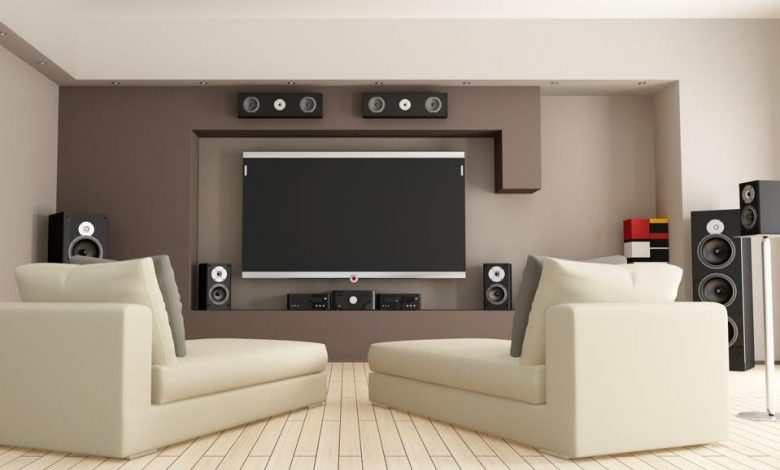Best Home Theater Systems of 2023

Built-in TV speakers are fine for watching the news and TV show, but they aren’t good enough for watching a movie, playing an action-packed game, or listening to your favourite music. Entertainment is everything that wraps around you and fills the room so that every word, raindrop, rumble, and note wraps around you.
The best home theatre systems get people interested and help them let go of reality for a while so they can relax. Read on to find out what you should think about when shopping for a home theatre system and to see a list of some of the best products you can buy.
How To Choose the Best Home Theater System
Buying a home theatre system is usually a big investment, so when looking for the best one, make sure it fits the size of the room. If it’s too big, it can take over the room. If it’s too small, you won’t get the effect you want. Think about how easy it is to instal and how much you want to change the room. Make sure you have enough space, a good layout, and the right tools to get the most out of the system.
Speaker Type
A home theatre system has many speakers or channels that make you feel like you’re right in the middle of a movie. There can be more than one driver for each channel. Midrange drivers handle midrange frequencies, and tweeters handle high-frequency treble frequencies. Both sounds come from a full-range driver.
A centre speaker sits below the TV and sends out about half of the music and sound effects, as well as most of the dialogue.
- The original music from a movie is played back by the left and right front speakers, which adds to the feeling.
- Sounds like raindrops, crowds, or birds come from the side and/or back speakers.
- Subwoofers make bass that is strong and deep, so you can feel the explosions and tension.
- Soundbars are long bars that sit under the TV and hold all of the speakers in one place.
- Some soundbars have three speakers in the front and separate right and left speakers on the sides or back.
- Speakers on the ceiling or facing up make sounds that come from above.
Wireless vs. Wired
Wired home theatres don’t need an outlet in the wall, but each speaker must be connected to an AV receiver. If you have a big room with speakers on the sides and back, you may need feet or even yards of wiring. Each speaker needs to have its own wire, which must be bought separately and stripped to the right length.
Even with the small problems, these setups are often cheaper than wireless ones. Also, unlike wireless systems, wired systems don’t have annoying audio and video lag (delays).
Sometimes, a wireless system will need a wired connection between the back speakers and the subwoofer, but most of the time, all you need is a power cord to connect each speaker to an electrical outlet. Sometimes a sound bar or a wireless transmitter is used instead of a receiver. Also, read Best Home Cleaning Services.
Number of Speakers
The two most popular setups are:
A 5.1 surround-sound system has a centre channel, left and right front speakers, side or back satellite speakers, and one subwoofer. This set-up works well in rooms that are less than 350 square feet in size.
A 7.1 surround sound system has one subwoofer and speakers in the front right, front left, side, and back.
There may be more than one subwoofer in some home theatre sets. A 7.2 surround sound system has seven speakers and two subwoofers. For a 7.1.2 or 7.1.4 speaker setup, you can also add two or four speakers that point up or toward the ceiling.
Speaker Placement
Speaker placement is very important if you want to get the most out of a new home theatre system. The centre speaker or channel should be placed below the TV, and the left and right front speakers must be placed on both side of the TV. If you want the best sound, imagine a triangle between a person sitting on the couch and all three speakers. Don’t worry if you can’t make that triangle; you probably won’t notice. Putting front speakers in the right place could be helped by an entertainment centre.
The rear speakers should be placed behind you, one to the right and one to the left. The side speakers should be placed to the right and left of your listening position. The best bass comes from subwoofers that are placed in the front corner of the room on the front wall.
Sound Quality
Voice matching and tweeters both make a home theatre system sound better.
If you use speakers made by the same company and from the same family or line, they will all sound the same. Voice-matching makes the sound flow smoothly and evenly throughout the room.
Tweeters make high-pitched sounds that woofers and other types of speakers can’t make. Tweeters improve clear sounds like horns and vocals and make it sound like the music is coming from everywhere.
Most of the time, tweeters are in the same box as the woofer and the midrange speaker. The woofer will handle sounds that are low and the midrange will handle sounds that are in the middle. All three work together to make a full and accurate copy of the sound.
Volume and Sensitivity
Speaker sensitivity is how well the speaker can turn power into sound or how much power it needs to work right. Most of the time, a microphone or sound pressure level (SPL) metre is placed about 3 feet away from the centre speaker to measure sensitivity. A signal is sent when the amplifier is hooked up and putting out one watt of power. The sensitivity is equal to the number of decibels (dB) used to measure it.
The speaker will play louder the more sensitive it is. The sensitivity of the average speaker is 88 dB. High-performance speakers are ones that have a sensitivity of 92 dB or more. If the sensitivity is less than 84 dB, the sound quality will be worse. In a home theatre system, each speaker should have the same level of sensitivity. Also, read Best Pest Control Services.
To put all of this into perspective:
- Between 65 and 75 dB is a normal speaking voice.
- Between 70 and 90 dB, a hair dryer is loud.
- Between 95 and 110 dB, a motorcycle is loud.
Additional Features
Some additional features to look out for:
- You can connect your tablet, phone, and other mobile devices to stream music wirelessly if the receiver or soundbar has Bluetooth.
- You can stream your favourite TV shows and movies if the device is compatible with video streaming devices.
- Not all home theatre systems come with the necessary cables, so it’s a plus if you can find one that comes with speaker wire, an HDMI cable, or any other cable you need.
- Look for a home theatre system with a lot of inputs or good wireless capabilities to connect all the different parts you want to use. These could be HDMI, component, RCA, or optical inputs that let you connect a TV, game console, and anything else you want to hear through your brand-new home theatre system.
- Some receivers let you use Amazon Alexa or Google Assistant to control them with your voice, so you can add them to your smart home.
Setup is easy
A wired home theatre system takes more work to set up than a wireless system. For power, you’ll need to connect each speaker to the amplifier. To do this, you’ll need speaker wire, and you might need to strip the wire and put banana clips on it. It also means coming up with creative ways to hide the wires if you don’t want to tear the room apart and start over. In a wireless setup, the speakers don’t connect to the receiver or soundbar. Instead, each speaker plugs into a wall outlet to get power. You might want to plug your devices into a surge protector to protect them from power surges.
In either case, look for products with clear setup instructions and information about the platforms, devices, and systems that the product works with. Before you buy, check the product’s specifications to make sure that your new home theatre system will work with all of your devices.
Best Home Theater Systems
Based on the above tips for shopping, here are some of the best home theatre systems in a variety of categories.
1) Nakamichi Shockwafe Ultra 9.2.4 Channel 1000W
The home theatre system from Nakamichi has a soundbar, two subwoofers, four surround and back speakers, and a total power of 1,000 watts. The all-in-one soundbar has six full-range speaker drivers and two tweeters that bounce sound off the walls. This gives it a 35 percent wider sound profile than other soundbars. With their explosive energy, the two subwoofers pull the user into the action, while the four two-way sound effect speakers send sound in all directions. Users can use the four speakers separately in a large room or connect them to make a pair of dipole speakers in a smaller space. Both ways give the same 360-degree effect.
With one HDMI ARC port, three HDMI ports, one optical input, and one coaxial input, users can connect up to six devices to the wireless surround sound. Users can also use Bluetooth to connect their mobile devices. The Shockwave can handle 1,000 watts, 110 dB, and Dolby Atmos.
Specifications
- Soundbar is 3 inches high, 45.5 inches wide, and 3.6 inches deep; subwoofer is 20.5 inches high, 12 inches wide, and 13.5 inches deep.
- RCA, optical, HDMI, and coaxial are all ways to connect speakers.
- Dual wireless subwoofers are a special feature.
Pros
- High-quality movie theatre sound; great for watching movies
- Spreads bass evenly throughout a room so that it can’t be pinpointed.
- Easy to set up, and you can link up to six devices.
Cons
- 2- to 3-second delay before sound starts
- The soundbar could make noise over HDMI
- Not easy to switch between types of input
2) Doss SoundBox Touch Portable Wireless Speakers
The Doss SoundBox Touch Portable Wireless Bluetooth Speakers have 360-degree high-definition sound and bass for listening on the go. It connects to smartphones and other devices using Bluetooth, and it connects automatically to the last device used. The speaker has high-performance 12-watt drivers and a bass setup that gives it a full sound with less than 1% harmonic distortion. A high-efficiency Li-on battery lets users listen to music without stopping for up to 20 hours straight.
The micro USB charger lets users charge the battery in less than four hours after it runs out. It only weighs 1.23 pounds, so people with active lifestyles or those who want to use it on the go might like it.
Specifications
- It’s 2.9 inches tall, 6.6 inches wide, and 2.7 inches deep.
- Bluetooth, MicroSD, and a 3.5-millimeter auxiliary-in jack let you connect speakers.
- Things to note: Built-in microphone, doesn’t get wet
Pros
- Two high-performance drivers give you better bass and a fuller stereo sound.
- Touch controls make it easy for users to change tracks and volume.
This is a great choice for pool and beach parties because it won’t get wet. - It can be played for 20 hours at 50% volume, which is more than enough for most users.
Cons
- Few mid- and low-range sounds, which makes music sound flat.
- A loud, low-battery warning tone
- After a while, the battery doesn’t hold a charge very well.
3) JBL Bar 9.1 – Channel Soundbar System with Speakers
With this JBL soundbar, you can get 9.1 surround sound. It has two magnetic satellite speakers that can be taken off and put anywhere. This makes it easy to get a full-on surround sound experience at home. When docked with the soundbar, the speakers have a battery life of 10 hours and can be charged in 3 hours. Even with the speakers attached to the soundbar, users can still watch their favourite movies and TV shows.
The 820 watts of power in the soundbar make the sound crystal clear, and the 10-inch wireless subwoofer makes the action even better. Users can stream music, podcasts, and more with Bluetooth, and HDMI and HDMI ARC ports add more compatibility.
Specifications
- Soundbar is 2.4 inches high, 34.8 inches wide, and 4.7 inches deep; subwoofer is 17.3 inches high, 6.8 inches wide, and 4.7 inches deep.
- HDMI is used to connect speakers.
- Things to note: Dolby Atmos and DTS:X decoding are already built in.
Pros
- The 820 watts of total system power give you loud, clear sound.
- The 10-inch subwoofer has bass that makes your heart pound.
- Two separate speakers give you a 9.1 surround-sound movie experience.
- Dolby Atmos and DTS:X make it possible to hear sounds in 3D.
Cons
- There may not be enough sound control options for the best sound quality.
4) Sony HT-S350 Soundbar with Wireless Subwoofer
With this 2.1-channel soundbar from Sony, you can enjoy the music and sound effects without missing any of the dialogue. This system is great for small rooms because it has a slim subwoofer that can stand up in a corner or lay flat under the sofa. It also has a soundbar with seven different sound modes, such as cinema, music, gaming, sports, and more. The HDMI connection lets people use their TV remote to control the soundbar, and Bluetooth lets people connect mobile devices.
One great thing about the Sony HT-S350 is that users can turn on Voice Enhancement, which helps isolate and amplify voices. This is great for TV shows or movies where action or other background noise can sometimes make it hard to hear what is being said, so that viewers can actually hear the dialogue. Also, read Best Home Cleaning Services.
Specifications
- Product dimensions: The soundbar is 2.5 inches high, 35.4 inches long, and 3.5 inches deep. The subwoofer is 15 inches high, 7.5 inches wide, and 15.4 inches deep.
- HDMI, optical digital audio, and Bluetooth are all ways to connect to a speaker.
- Things to note: Voice enhancement, virtual surround sound
Pros
- Most other options are thicker than the subwoofer, which makes it great for small spaces.
- Users can easily connect to other devices when they have Bluetooth.
- Can pick out and boost just the dialogue, making it perfect for loud movies and TV shows
Cons
- Doesn’t come with extra speakers for a real surround-sound experience
5) Samsung HW-Q950T 9.1.4ch Soundbar with Dolby Atmos
This Samsung soundbar works with both Dolby Atmos and DTS:X, so the user can hear every sound as it moves through the room. The nine surround channels, one subwoofer channel, and four up-firing channels that bounce sound off the ceiling wrap the sounds around the viewer, and the rear speakers help fill the space and improve the experience. After figuring out what each scene is about, the smart soundbar automatically delivers the best sound.
The soundbar works with Amazon Alexa because it has a voice assistant built in. This lets users control their music, plan their day, and get information like weather forecasts with simple voice commands. Users can connect up to two smartphones to the soundbar at the same time via Bluetooth and switch between playlists. There is also an HDMI ARC port on the soundbar.
Specifications
- Soundbar is 2.7 inches high, 48 inches wide, and 5.4 inches deep; subwoofer is 15.9 inches high, 8.3 inches wide, and 15.9 inches deep.
- Wi-Fi is used to connect speakers.
- Dolby Atmos and DTS:X are special features, and the Amazon Alexa voice assistant is built in.
Pros
- 20 speaker system envelopes users in sound
- Q-Symphony syncs the speakers on a Samsung QLED TV with the soundbar.
- Wireless speakers that fire upward sound like a movie theatre.
- analyses the content and delivers the best sound automatically
Cons
- There are a lot of settings and options, and it can be hard to programme.
- Black speaker covers made of mesh fabric can get dirty and are hard to clean.
- Audio and video may stop working because of connection problems.
6) Polk Audio 5.1 Channel Home Theater System
This home theatre speaker system bundle from Polk is perfect for people who want to feel like they are at the movies. Each of the two bookshelf speakers has a driver that is 5.35 inches wide and a tweeter that is 0.75 inches wide. Each tower has a 6.5-inch driver, a 1-inch tweeter, and two 6.5-inch bass radiators to fill the room with sound. The centre speaker has a 5.25-inch driver and a 1-inch tweeter. The 10-inch subwoofer can handle 100 watts and has a directional port that is set up in a unique way to make deep, accurate bass. Each speaker in this home theatre system has a technology called “dynamic balance” that makes the sound spread farther and has less distortion.
Specifications
- The height, width, and depth of the floor speaker are 36.5 inches, 9.25 inches, and 8.75 inches, respectively. The height, width, and depth of the centre speaker are 6.5 inches, 19 inches, and 8.5 inches, respectively.
- Most AV receivers have a way to connect speakers.
- Things to note: A 10-inch, 100-watt subwoofer adds more bass.
Pros
- The 10-inch subwoofer adds depth and bass.
- 3D sound that spreads farther and has less distortion
- This cheaper option can compete with much more expensive ones.
Cons
- Problems with sound clarity; 3D sound may seem off.
- Has trouble making good highs or lows, but does well in the middle.
7) Samsung HW-Q900T 7.1.2ch Soundbar with Dolby Atmos
Alexa users might want to look into this Samsung soundbar, which has an Alexa voice assistant built in. Users can do everything they love with Alexa and get better sound in every part of the room.
This soundbar works with Dolby Atmos and DTS:X, so users can hear each sound clearly as it moves around the room. The 7.1.2 home theatre system has seven channels, one subwoofer channel, and two up-firing channels. A total of 16 speakers power the sound, which fills the room. The soundbar looks at the content of each scene and adjusts the sound automatically. Users can connect their phones to the soundbar through Bluetooth and listen to their favourite playlists and podcasts.
Specifications
- Soundbar is 2.7 inches high, 48 inches wide, and 5.4 inches deep; subwoofer is 15.9 inches high, 8.3 inches wide, and 15.9 inches deep.
- Wi-Fi is used to connect speakers.
- Special features include a stylish Kvadrat design, Dolby Atmos and DTS:X sound, and an Amazon Alexa voice assistant that is built in.
Pros
- Strong, with a stylish look and the latest technology
- 16 speakers make 3D sound that fills the room.
- Plays music from a device that has been paired and is compatible.
- The sound quality is good with HDMI eARC.
Cons
- Audio and video can sometimes be out of sync with each other.
- When streaming music, it tends to skip.




